Starting with psychology
Use 'Print preview' to check the number of pages and printer settings.
Print functionality varies between browsers.
Printable page generated Tuesday, 23 April 2024, 5:09 PM
Starting with psychology
Introduction
What makes us who we are? This course will look at a number of different explanations that psychologists put forward in their attempts to understand why people feel, think and behave the way they do.
This OpenLearn course provides a sample of level 1 study in Psychology & Counselling
This course is also available in Welsh on OpenLearn Cymru.
Tell us what you think! We’d love to hear from you to help us improve our free learning offering through OpenLearn by filling out this short survey.
Learning outcomes
After studying this course, you should be able to:
analyse a range of factors within and outside individuals which influence mind and behaviour
consider multiple influences in case studies
describe the way that influences are interlinked in complex ways
discuss the multiple factors involved in what makes us happy.
1 Studying people
The British Psychological Society defines psychology as:
The scientific study of people, the mind and behaviour.
(British Psychological Society, 2007)
If you are reading this you are probably interested in people and curious about what is going on in other people's minds and you want to understand more about why people behave as they do.
However as you study psychology you will probably find that you will be asking more and more questions rather than finding straightforward answers. The reason for this is that when you study psychology you are studying people, and people are complicated and can be changeable.
Try out the activity below and you'll start to see why trying to give a single simple explanation for human behaviour is almost impossible.
Activity 1: Boys' toys and girls' toys
In the photograph below there are two children playing with toys. You will see that the boy is playing with the truck and the girl with the doll. Most children, when given a free choice of toys, tend to select the toys that are thought to be appropriate for their sex. Can you explain why they behave in this way? You can give as many explanations as you want, even some that you don't agree with but think other people might come up with.
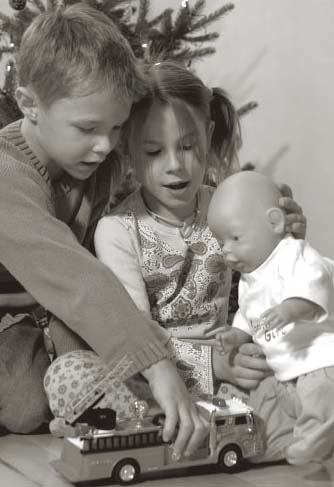
Discussion
There are lots of possible explanations for this. Have a look at the list below and compare it with yours. It doesn't matter if your responses are different, that only goes to show how complicated explaining behaviour is!
It is because boys and girls are biologically different. Girls are naturally more motherly and they pick dolls whereas boys are naturally more interested in cars and trucks.
I think that sometimes boys might want to play with the dolls but they think that because they are a boy they should pick boys' toys.
It is to do with the way they have been brought up as the adults around them tend to give girls dolls and boys trucks. Also children are often influenced by their friends. Boys will often make fun of other boys who play with dolls.
It has a lot to do with television and particularly adverts aimed at children. When they are trying to sell dolls, advertisers show girls, not boys, playing with them.
In trying to understand the children's behaviour we have a number of explanations that suggest the reasons for the choice of toys could be related to:
the child's biological sex
what they think is the right kind of behaviour for their sex
their upbringing and the way they are treated by adults and their friends
wider cultural influences from television and other forms of media.
In the following sections you will be able to have a brief look at a number of different explanations that psychologists use in their attempts to understand people. You'll start with the influence of biology, specifically the brain, on behaviour and then consider how the way people think about their world will affect their behaviour. Next you'll explore the influence of close relationships and finally you'll see how identity is shaped by groups and the wider culture.
2 A brain of two halves
2.1 Introduction
If you are not too squeamish, imagine you have lifted the top off someone's skull and peeled back a thin protective membrane. You are now looking down on the brain sitting in a pool of liquid. You have probably heard the phrase ‘grey matter’ and one of the first things you would see is that the outermost layer of the brain is indeed slightly grey in colour. It also has many dips and folds.
You would also notice that the brain is divided into two halves or hemispheres with the division running from the front to the back of the brain.
These two hemispheres are joined together by a bundle of approximately 200 million nerve cells that pass messages between the two hemispheres. This connecting bundle of cells is called the corpus callosum.
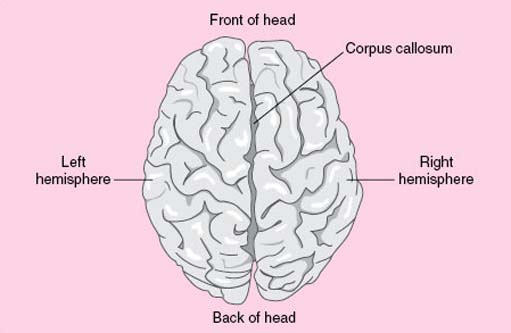
Although these two hemispheres look the same, so they have a similar structure, there are differences in the way they function so they control different responses. For example the left hemisphere controls and receives information from the right side of the body and the right hemisphere controls and receives information from the left side of the body.
The two hemispheres may also differ in the extent to which they control certain functions such as producing speech, daydreaming or recognising someone's face. Some functions may be more under the control of one hemisphere, so that hemisphere will dominate the other. Other functions may be shared equally by both hemispheres. For example our speech area is usually located in the left hemisphere except in some, but not all, left-handed people who may have areas controlling speech on both the left and the right hemisphere. Conversely both hemispheres play a role in vision although it is the right hemisphere that receives information from the left visual field and the left hemisphere that receives information from the right visual field.
You will have noted from the mention of left-handed people above that not all brains are organised in the same way. Another finding in this area is that males, especially right-handed males, have greater left hemisphere dominance for speech than females. If a man suffers damage in the speech area of his left hemisphere this will have a greater impact on his speech compared to a woman who has suffered similar damage.
However, bearing in mind that there will be some differences between people in the way that their brains are organised, we do have a range of evidence that suggests that generally the two hemispheres are dominant in different areas. The left hemisphere dominates for speech, writing, mathematical ability, logic and analysis. The right hemisphere dominates for perception, spatial ability, musical and artistic abilities, imagery and dreaming. The right hemisphere also seems to be more emotional and negative compared to the positive and rational left hemisphere.
Evidence to support the proposal that one hemisphere may dominate the other for a particular function, or hemispherical specialisation, has come from a number of sources. In this section you will consider what has been learned through research with people who have had an operation that splits the left hemisphere of the brain from the right hemisphere of the brain.
2.2 The story of the split brain patients
A surgical procedure that cuts through the corpus callosum has provided evidence to support the different specialisations of the left and right hemispheres of the brain. This procedure is used very rarely and always as a last resort when someone has frequent and major epileptic seizures that do not respond to drug treatment. The frequency and severity of their epileptic fits is very disabling and their quality of life is poor. The attacks can even be life threatening. In these patients epileptic activity would start in one area of the brain and then spread across the corpus callosum to all areas of the brain. By cutting these connections between the two hemispheres epileptic activity is contained in one hemisphere only. The operation usually leads to a significant decrease in the frequency and severity of the seizures without any apparent interference in normal functioning.
Early researchers were puzzled by the fact that people who had undergone this operation did not show any noticeable changes in behaviour, personality or their scores on intelligence tests despite such extensive surgery. In fact they wondered what the purpose of the corpus callosum was if you could cut through it with so little effect. However careful testing by Roger Sperry (1968) and colleagues did uncover behaviour that was far from normal. This work was to gain him a Nobel Prize for Medicine in 1981.
Sperry et al, devised a number of split brain experiments using people who had had split brain surgery as participants and comparing their responses to people who had not had this surgery. In one experiment the split brain participant was blindfolded and given objects to explore with their left hand. Information from the left hand goes to the right hemisphere but speech is generally controlled by the left hemisphere.
Participants were unable to tell the experimenter the name of the object they were holding in their left hand even though they could obviously recognise the object because they would make appropriate gestures with it. For example, if the object was a key they would hold it out as though putting it in a lock and turn it. Because the right hemisphere does not talk and could not transfer information to the left hemisphere the object cannot be named. However as soon as the participant touched the object with the right hand they were able to name it instantly.
In another experiment the participant would sit at a table with a screen in front of them. They would be asked to place their hands round the sides of the screen so that their hands were hidden from view. They would then be asked to fix their eyes on a spot in the centre of the screen.

A word is then flashed onto one side of the screen very briefly (approximately one tenth of a second). The word has to be flashed very quickly so that the participant does not have time to move their eyes and the information will only go to one of the brain hemispheres.
When a word is flashed on to the left-hand side of the screen the information will go to the right hemisphere of the brain. The information cannot be passed to the talkative left hemisphere so the participant cannot tell the experimenter what the word was.
However the participant can use their left hand to explore a pile of objects behind the screen and easily pick out the object that corresponds to the word that has been flashed up. They still won't be able to tell the experimenter what the left hand is doing as sensory information from the left hand is going to the silent right hemisphere only. Also they can't find the right object with their right hand as the right hand is controlled by the left hemisphere and the left hemisphere did not see the flashed word.
Activity 2: Sorting out right from left
Reading about split brain experiments can be a little confusing as you try and sort out right and left hands, hemispheres and sides of the screen. Taking some time to do this activity should help to make things clearer.
1 If a word is flashed on the right hand of the screen will a person with a split brain be able to:
| Yes | No | |
|---|---|---|
| (a) name the word |
To use this interactive functionality a free OU account is required. Sign in or register.
|
To use this interactive functionality a free OU account is required. Sign in or register.
|
| (b) pick out the corresponding object from behind the screen with their right hand |
To use this interactive functionality a free OU account is required. Sign in or register.
|
To use this interactive functionality a free OU account is required. Sign in or register.
|
| (c) pick out the corresponding object from behind the screen with their left hand |
To use this interactive functionality a free OU account is required. Sign in or register.
|
To use this interactive functionality a free OU account is required. Sign in or register.
|
Discussion
Don't worry if you found this activity difficult. Many people find following a path from a word on the right side of the screen to the left hemisphere of the brain and then to the right hand far from easy.
In question 1 the word was flashed on the right side of the screen so the information will go to the left hemisphere of the brain. As speech is usually controlled by the left hemisphere the person should be able to name the word. As the left hemisphere also controls the right side of the body the person will be able to pick out a hidden corresponding with their right hand but not with their left hand.
So the answers to question 1 are
(a) yes
(b) yes
(c) no
Activity 2b
2 If a word is flashed on the left hand of the screen will a person with a split brain be able to:
| Yes | No | |
|---|---|---|
| (a) name the word |
To use this interactive functionality a free OU account is required. Sign in or register.
|
To use this interactive functionality a free OU account is required. Sign in or register.
|
| (b) pick out the corresponding object from behind the screen with their right hand |
To use this interactive functionality a free OU account is required. Sign in or register.
|
To use this interactive functionality a free OU account is required. Sign in or register.
|
| (c) pick out the corresponding object from behind the screen with their left hand |
To use this interactive functionality a free OU account is required. Sign in or register.
|
To use this interactive functionality a free OU account is required. Sign in or register.
|
Answer
The word is flashed to the left side of the screen so the information will go to the right hemisphere. The person will not be able to name the word and will not be able to pick out a corresponding hidden object with their right hand. This is because the right hemisphere does not control speech or the right side of the body. The right hemisphere controls the left side of the body so the left hand will be able to select a corresponding object.
So the answers to question 2 are the opposite to those for question 1:
(a) no
(b) no
(c) yes
In split brain experiments the techniques used will limit information to one hemisphere only and the person behaves as if they have two separate brains with each hemisphere appearing to operate with no conscious awareness of what is happening in the other hemisphere.
Of course in everyday activities split brain people can operate normally because they can move their eyes and make sure that incoming information is available to both hemispheres. Occasionally odd behaviours do occur, especially in the early days after surgery. A patient might find that they are buttoning up a shirt with one hand and unbuttoning it with the other hand or that their left hand suddenly closes a book that they were engrossed in.
3 It's the thought that counts
3.1 Organisation and improved recall
This section will concentrate on thinking and specifically how we organise our thoughts, how we make sense of our world and how we remember (or sometimes forget) what is relevant.
Psychologists who study thinking are working in the area of cognitive psychology. Cognition means knowledge so cognitive psychologists are interested in what knowledge people have, how they have acquired this knowledge and how they use this knowledge. This means that the areas they study include attention, perception, memory, problem solving and language.
Organising our thoughts involves:
using mental images
forming concepts (putting information into categories)
developing schemas (constructing mental packages of related information).
We will now look at these three types of organisation in more detail.
3.2 Using mental images
As adults, we tend to do most of our thinking in words. However numerous experiments have been carried out that support the suggestion that we will remember verbal or written information better if we also form a mental image of the information. The mental image will give us another cue when we come to recall the information. In addition the effort we make in forming the image will help to fix it in our memory. This works best if the images we form are large colourful and bizarre as we tend to remember distinctive items rather than everyday items.
Using mental images when you first start to learn a new language has proved very effective for helping people grasp basic vocabulary. This is the key word technique. For example take the French word ‘poubelle’ (pronounced pooh-bell) which translates as ‘bin’ in English. The first step is to think of an English word or words that sound like the French word or part of the French word. This will give you your key word. Then you make a mental picture of the key word with the English translation. So in this example you could picture yourself lifting the lid off your bin which has turned into a bell and holding your nose because of the ‘pooh’.

This might sound complicated, but doing it is much simpler than describing it. It is very successful as well as being a lot less effort and more fun than learning lists of vocabulary by repeating the words over and over again.
Michael Raugh and Richard Atkinson (1975) developed this key word technique and carried out an experiment on two groups of participants. The participants were asked to learn a list of 60 Spanish words but only half of them were taught to use the key word technique. When they were tested later the participants using key words scored an average of 88 per cent compared to only 28 per cent for the participants who did not use key words.
This study by Raugh and Atkinson is a good example of a simple experiment. The experimenters had two groups of participants and they manipulated one difference between the two groups. The experimental group were taught to use key words and the control group were not. Both groups were then given a memory test. In experiments the thing that the experimenter manipulates is called the independent variable and the thing that the experimenter measures is called the dependent variable. When researchers design experiments they do need to consider whether any other factors or variables might be influencing their results. It is important that the experimenter tries to eliminate or control these variables.
Activity 3: Identifying variables
In the Raugh and Atkinson experiment can you identify the following variables?
the independent variable
the dependent variable
a variable that should be controlled.
Discussion
The independent variable is the variable that the experimenter manipulates so this is the instruction to use the key word technique.
The dependent variable is the variable that alters as a result of the manipulation of the independent variable. The experimenter measures this variable and it is the number of Spanish words recalled.
One variable that the experimenter might need to control is to make sure that none of the participants had learnt any Spanish before the experiment as this could affect their score on the memory test.
A number of mnemonics or memory strategies are based on using mental images. A mnemonic is a strategy for improving memory and you are probably familiar with several mnemonics such as the rhyme ‘30 days hath September, April, June and November, all the rest have 31 except February which has 28…’ or ‘Richard Of York Gave Battle In Vain’ to remember that the rainbow is made up of Red, Orange, Yellow, Green, Blue, Indigo and Violet.
An ancient mnemonic device called the ‘method of loci’ was developed by the poet Simonides who lived in Ancient Greece in the year 500 bc. This technique works by the learner linking mental images of the items they are trying to remember with a sequence of locations that they already know.
Activity 4: Method of loci
Let's take a simple example. Suppose you wanted to remember a list of ten items that you need to shop for.

You would imagine each of these items at various locations around your home or placed at different points down a street that you know well. Remember this technique works best if the images are outstanding and silly rather than sensible. I have suggested some images for our list in the passage below. Please read through the passage and take a moment to make the mental pictures but don't worry too much about trying to remember the items. However it is very important that you do make the picture in your mind.
Try to imagine your front door but with a huge banana instead of the usual handle. When you open the door and walk into the entrance the floor is covered in eggs and you have to walk over the eggs to get to the living room. Imagine the eggs cracking under your feet and the mess! Anyway it gets much messier because when you open the living room door you are almost knocked off your feet by the river of milk that comes gushing out. You stagger over to the window to pull the curtains which have turned into two giant slices of bread. You try to turn on the TV but fail because that has been replaced by a very large packet of cereal. Time to have a sit down, but when you collapse on the sofa you sink down into a sofa sized ginger cake. Go to the kitchen for a drink. Walking across the kitchen floor is a bit difficult as it is knee deep in sugar and when you have reached the kettle you find it has turned into a bottle of wine. I prefer white but you can visualise red if you want. Give up and go for a mug of water. Unfortunately when you reach down a mug from the cupboard it is filled with a bouquet of flowers and when you turn the tap on it is chocolate not water that comes out.
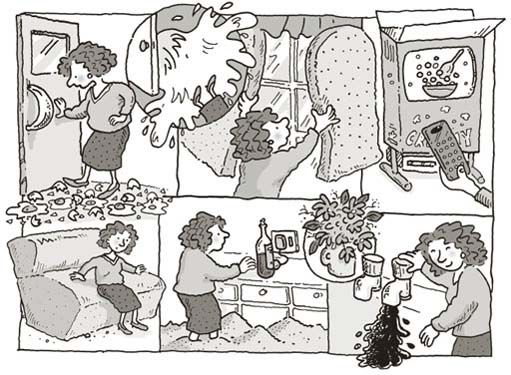
Discussion
Leave the shopping list now at least for an hour and in the meantime try not to keep checking whether you have remembered the items. You will probably find that an hour or so later you will be able to remember most of the items on the list. You will even find that a few days later you will still be able to recite most of the list.
This is a fairly trivial example and that most of us would just write our shopping list down. However hopefully it has demonstrated for you that making mental images can be a powerful aid to memory. The technique can be adapted for other more relevant situations. It has been tested on students revising for exams where it has been found to improve recall. For example if you had to take a psychology exam you could make up mental images of some of the research you have read about and arrange these images in a logical sequence around your home.
Using mental images to organise our thoughts can make our thinking and remembering much more efficient. However there are other organising principles which can also be useful such sorting information into categories.
3.3 Forming concepts
When we think about the world one of the ways that we organise our thoughts is by putting them into categories. This process of developing categories is called concept formation. For example ‘animal’ is a concept that contains other sub-concepts and then further sub-concepts. We could divide animals into birds, fish, mammals, etc. We could then divide birds into robins, sparrows, owls, etc. When we apply our concepts we tend to use a set of defining features. For example we would classify the sparrow as a bird because it has a number of defining features that we associate with birds such as wings, feathers, beaks and flying. However although we may have a set of defining features for a concept such as a bird we don't apply these rigidly. Penguins and ostriches are still classified as birds even though they don't fly.
Activity 5: Defining a simple concept
What makes a table a table? We all have a concept of what a table is and can easily recognise a table whether it is a dining table, garden table or coffee table. Can you take a moment to write a list of the defining features of a table?
Discussion
Most people when asked this relatively simple question will tell you that a table has a flat surface, four legs to raise it off the ground and you can put things on it. They may add other features such as it is an item of furniture or it is often but not always made of wood, but the first three features are the most frequent responses.
However look at the picture below.
This table doesn't have four legs but most of us would still recognise it as a table as it has a flat surface that we can put things on.
Similarly our definition of a table as a piece of furniture with a flat surface with four legs could just as easily be applied to a stool.

So while we would find it difficult to specify a way of distinguishing between a small occasional table and a stool we would not walk into someone's living room and sit on their occasional table because it shares the same the features as a stool. So our concepts are not clearly defined and seem to depend on what we expect to do with an object rather than how we define them. You may have heard the phrase ‘fuzzy concept’ which reflects our difficulty in providing precise definitions.
So we recognise the object in Figure 7 above as a table because we could use them to put things on such as a book, our drink or an ornament. The object in Figure 8 is a stool because we would sit on it. We will group objects within the same category or concept if we do the same thing with them.
We use concepts so automatically that we are rarely aware that we are using them. Perhaps it is easier to see this process in action when we observe children developing their thinking as they struggle to develop concepts. Children often make mistakes by overgeneralising a concept that they are trying to get to grips with. They may have developed a concept for a dog as an animal with hair, four legs and a tail, but then they may also apply this label to a cat or a sheep or even a horse. Similarly they may learn that the tall person with the deep voice is called Daddy and then may embarrassingly identify any passing man as Daddy.
It may also become evident how much we use concepts when we look at a few memory experiments. Try the first experiment for yourself in the activity below.
Activity 6: A memory test
Read once through the list of words below trying to remember them and then scroll the screen until the list disappears but you can still see the ‘Reveal discussion’ link. Once you have written down as many words as you can remember click to read the discussion.
Bed
Peach
Hat
Armchair
Daffodil
Shirt
Rose
Lemon
Sock
Daisy
Strawberry
Table
Buttercup
Apple
Sideboard
Trousers
Discussion
Now that you have written all the words down that you can recall, I would like you to see if you can remember any more words with the help of some cues. The list contains items belonging to the following categories; furniture, fruit, clothing and flowers. Have the cues helped you remember any more words?
Have a look at your first try at recalling the words. Did you realise that the words belonged to categories and did you recall them in category clusters?
If possible you could try this out on some other people and compare their results with yours.
This experiment is a simplified version of an experiment by Weston Bousfield (1953). Bousfield asked participants to learn a list of 60 words that could be divided into four categories. Though the words were presented in a random order, the participants tended to remember them in groups which belonged to the same category, so if they remembered apple, then they would remember peach, lemon and strawberry.
In our version of the experiment you were also asked to have a second go at recalling the words after you had been given the category headings. Most participants in these types of experiments find that although they think they have recalled all the words they will be able to remember, they can actually access more words once they have been given category headings as cues.
This illustrates that this information must have been available but without the cue they could not access it. When we try to recall information that has been organised it seems each bit of the information cues the next bit because we have it stored in an organised rather than haphazard fashion.
Some research from George Mandler (1967) suggests that by organising information we learn it even though we are not making any effort to memorise it. Mandler carried out an experiment where two groups of participants were given a pack of 100 cards each. Each card had a word printed on it. Both groups of participants were told to sort the cards into groups. They were allowed to have several tries at sorting the cards. The only difference between the two groups of participants was that the first group were told to try and memorise the words on the cards while they were sorting them but the other group were only told to sort the cards. When both groups were later tested by being asked to write down all the words they could remember the group who were only told to sort the words remembered as many words as the group who were told to sort and memorise the words.
Activity 7: Identifying variables again
In the Mandler experiment can you identify the following variables?
the independent variable
the dependent variable
Discussion
The independent variable is the variable that the experimenter manipulates so this is the instruction to try and memorise the words which was given to one group only.
The dependent variable is the number of words recalled.
You may rightly argue that being able to remember lists of words in category groups is not a particularly useful skill for everyday life. However the principle of organising information so that it is grouped with related items can be applied to activities like reading this course. You may be aware of mind mapping, which is simply a way of organising information so you can see which items go together and how they are related to other items.
Skim reading is a good way to get an overall idea of what is going to be covered in the material you are looking at. The titles, subtitles, bullet point lists and diagrams can help you see how the material has been organised. Keeping this organisation in mind can be a useful aid to study. You can start out with a rough sketch of how the material is organised and then add to it or amend it as you do your close reading.
We'll now look at a third way of organising our thoughts which is very similar to concept formation but is more extensive, and that is using schemas.
3.4 Schemas
A schema is the word psychologists use to describe a mental framework in which you would file all your knowledge about certain objects, situations, groups of people and even yourself. It would include the whole package of your thinking when you think about something. For example, if you apply concept formation to the word dentist you would probably categorise dentist as an occupation. However if you list everything that you associate with the word dentist this would give you your dentist schema. Your schema may include items such as a waiting room, dread, a dentist's chair, the sound of the drill, the smell of the antiseptic mouth wash and so on.
The term schema (plural schemas or schemata) was used by an influential Swiss psychologist named Jean Piaget. Piaget, who died in 1980, spent over 50 years investigating the way that children developed their thinking or cognitive skills. He proposed that they did this by developing schemas which are built up from their experience of the world.
It is as if your memory is a huge filing cabinet and each file in the cabinet is a schema. If you opened the schema labelled ‘going to the cinema’, it would contain all your knowledge about trips to the cinema (e.g. buying a ticket, sitting in the dark, seeing a film, other people around, eating popcorn). If you visited a cinema that you have never been to before you wouldn't have to start from the beginning in trying to work out what to do. You would simply activate your ‘going to the cinema’ schema to guide your actions. In this way schemas help us deal more efficiently with the world around us so when we encounter a new situation we can apply our knowledge of similar past situations to help us act appropriately.
A lot of the knowledge that we hold in our schemas will be shared with other people who have had similar experiences to ourselves. However where our experiences are different our schemas will also be different. For example, if you love football your schema for football will contain a lot of detailed information about particular teams, leagues, championship competitions and even the intricacies of the off-side rule. If you dislike football your football schema may only include the information that it is an outdoor game involving a ball, a number of players and an audience and that you should avoid it whenever possible.
Schemas can help us recall information as they provide an organising framework so that the information is stored appropriately and they can provide cues to prompt our memory.
John Bransford and Marcia Johnson (1972) carried out a number of experiments which illustrated the role of schemas in our understanding and recall of information. In one experiment the participants were read the passage below and then asked to recall it as accurately as possible. However half of the participants were given a title for the following passage and the other participants were given the passage without the title.
The procedure is actually quite simple. First you arrange things into different groups… Of course, one pile may be sufficient depending on how much there is to do. If you have to go somewhere else due to lack of facilities that is the next step, otherwise you are pretty well set. It is important not to overdo any particular endeavour. That is, it is better to do too few things at once than too many. In the short run this may not seem important, but complications from doing too many can easily arise. A mistake can be expensive as well… At first the whole procedure will seem complicated. Soon, however, it will become just another facet of life. It is difficult to foresee any end to the necessity for this task in the immediate future, but then one never can tell. After the procedure is completed one arranges the materials into different groups again. Then they can be put into their appropriate places. Eventually they will be used once more and the whole cycle will have to be repeated. However, that is part of life.
(Bransford and Johnson 1972 p. 722)
Most people report that they have great difficulty in understanding the passage let alone trying to recall the details. However if you reread the passage with the title, ‘Washing Clothes’ in mind everything should fall into place. The title provides a schema so that the information can be stored appropriately and recalled more easily.
4 Adult and intimate relationships
4.1 Introduction
As young people in the UK grow into adulthood the potential for establishing more intimate relationships opens up considerably when they leave home for university, enter vocational training, or move directly into the workforce. Each of these changes provides new opportunities for contact with a range of different people. These new settings often include opportunities to form close intimate relationships.
The bulk of research on relationships has concentrated on those in western societies, with its underlying idea of romantic love and free choice of partners. It should be remembered that this is far from the universal approach to long-term relationships. Would you be surprised to hear that the majority of marriages that take place in the world are more or less arranged or based on considerations beyond notions of romantic love? David Buss (1994) studied the citizens of different countries and found they tended to highlight different reasons for getting married. To give some examples, he found that in Iran factors such as education, ambition and chastity were seen as more important for choosing a spouse while in Nigeria, citizens ranked good health, refinement/neatness and desire for home/children highest. Also, most of the research carried out in this area has focused on heterosexual relationships. However it has been found that there are far more similarities between homosexual and heterosexual relationships than there are differences.
This section focuses on people's experiences of intimate relationships both in terms of what attracts us initially and what keeps us together in the longer term.
4.2 Attraction
What is it that attracts us to other people for these more romantic relationships? Psychologists have identified a number of factors to explain why we might be attracted to one person but not to another. Three of the most important influences are:
Proximity and familiarity
Similarity
Physical appearance
4.3 Proximity and familiarity
Proximity means geographical closeness. An obvious and basic requirement for forming a relationship is that the people involved need to be geographically close enough to have opportunities to interact with each other. You may find a certain film star very attractive but if you never get the chance to meet them or talk to them then you'll have no chance of forming a relationship. If you examine friendship patterns of people living in blocks of flats then they will be much more likely to be friendly with the people who live near them on the same floor than with people living on different floors just because they have more opportunities to meet and get to know each other. Similarly people are more likely to form friendships at work with the people working near them and students will be more likely to form friendships with people studying the same subject and attending the same classes.
Having more chances to interact with another person means that we become more familiar with that person and numerous studies have shown that we prefer people who are familiar to us rather than strangers. This is known as the ‘mere exposure effect’ (Robert B. Zajonc, 1968) which states that the more often we are exposed to a stimulus whether it is a sound, picture or person the more positively we will rate that stimulus. The reason why we are more likely to be attracted to people we meet more often may be because we feel more secure with people that we know. However, we are also more likely to be in regular close proximity to people with whom we share interests: working together, undertaking leisure activities, being within the same friendship group and similar social circumstances. You will see in the next section that similarity also has a part to play in attraction.
4.4 Similarity
The old adage ‘opposites attract’ is not particularly born out by research. In fact numerous studies suggest that we tend to be attracted to people who are similar to ourselves. This applies to whether we are considering friendships or more intimate relationships. Similarities can be seen in age, ethnicity, religion, social class, intelligence, interests and some aspects of physical appearance. However, research suggests the most important similarities are those concerning beliefs, values, attitudes and how people see the world. Steven Duck (1992) explained this is because seeing the world in the same way as someone else makes it easier to interact with them. It also increases our confidence in our own attitudes which in turn bolsters our self-esteem.
4.5 Physical appearance
Our society places particular value on physical characteristics. Curvy body shapes, long legs and luxurious hair are characteristics that are often seen as desirable in women. For men it might include characteristics such as muscularity, tallness and a firm jawline. For both sexes there is youthfulness, white even teeth, and facial symmetry. There is a vast amount of media coverage implicitly favouring, and in the case of the advertising industry explicitly promoting, these models of attractiveness. Films, magazines and television all contribute to what might be termed the tyranny of body shape images. There is a whole industry that aims to mould consumer preferences, and so sell products, by distorting the reality of normal into the unreality of ideals such as the so-called ideal of women being size zero.
Because the ideal of attractiveness based on physical characteristics rather than personality traits (such as kindness, intelligence, thoughtfulness, sense of humour) is continually being promoted in western societies, you might assume that relationships in the west would be based on physical characteristics. This assumption has been found to be true, but only up to a point. Whether or not it is true might be to do with the reason for the relationship, short-term fun or longer-term commitment.
Research suggests that what is valued in a partner also differs along gender lines. Catherine Cameron et al (1977) in a study of personal adverts found that women tended to promote themselves in terms of socially favoured personality and physical characteristics, such as sense of humour, outgoing, slim, attractive and so on. On the other hand, men tended to highlight their economic status, so will often use terms such as ‘professional’ or ‘homeowner’. This difference seems to suggest that women ‘think’ that men look for personal attractiveness whilst men ‘think’ that women want security – the wording of the adverts reflecting what each gender ‘thinks’ that the other is looking for – is supported by a range of research.
Activity 8: Testing Cameron's research
Find the personal ads section of a magazine or local newspaper. Go through the first twenty ‘women seeking men’ and make a brief note of how the women describe themselves, then do the same with the first twenty ‘men seeking women’. Do your findings support Cameron et al's findings?
Discussion
In this activity you started with a research question related to gender differences in how people promote themselves to potential partners. You then identified relevant ‘gender samples’ and then you undertook an analysis of the samples in relation to defined categories, which are items in the adverts that promote ‘socially favoured characteristics’ and those ‘promoting economic status’. So your research involved you taking a considered approach to ‘testing’ Cameron et al's findings.
Clearly the sample would be too small and the source too limited to provide a thorough test of gender differences in how people promote themselves in personal ads these days.
Some psychologists suggest that in order to understand why particular physical attributes are deemed attractive we need to consider human evolution. Darwin's theory of evolution and natural selection states that characteristics that give an animal or human the best chance of survival and of reproducing themselves will be prized. These psychologists would suggest that attraction based on physical characteristics is related to features which indicate healthiness and especially fertility.
Viren Swami and Adrian Furnham (2006) have undertaken an overview of recent research which examined this suggested influence on attraction based on physical characteristics. Their research focused on the heterosexual male perspective.
They pose the question of whether there are physical characteristics that are found to be attractive across cultures. If so, do these characteristics signal procreative potential as predicted by psychologists taking an evolutionary approach to explaining behaviour? Swami and Furnham conclude that there is research evidence to suggest that there are characteristics that have been shown to be attractive across cultures. The physical characteristics for females focus on body shape, especially the waist to hip measurement ratio (WHR). A WHR measure of 0.8 means that a person's waist measurement is 80 per cent of their hip measurement.

For a woman a WHR of around 0.7, is better than a high WHR, of 0.9 and over, in terms of health and fertility. In most cultures men will rate women with a 0.7 WHR as more attractive than a woman with a higher WHR. Popular evidence to support this is the fact that present day catwalk supermodels, as well as film stars of the 1950s such as Marilyn Monroe and, going back even further, the famous (armless) statue of the Venus de Milo all have WHRs in the 0.7 range.
However body weight may be even more important than WHR in determining attractiveness and Swami and Furnham report on research that shows some variation among cultures when they looked at this measure. Generally, in economically developed societies men tend to prefer women with a lighter build, while men in economically developing societies tend to prefer a heavier build. These cultural differences are explained by evolutionary psychologists suggesting that in societies where food supplies were poor or uncertain it was understandable that women with a high body weight would be seen as better choice of partner. In economically developed societies these more basic considerations which are focused on survival in difficult environments are not relevant and other factors may come into play.
The evolutionary approach is controversial, with most psychologists viewing it as much too simplistic, but it does offer a wide-ranging explanatory framework within which to begin to understand and interpret human behaviour.
The work of Swami and Furnham above has introduced some of the cultural variation in what people consider to be attractive for potential intimate relationships. There are a range of other features that have been considered to influence attractiveness. Whereas signs of healthiness are most important, once these have been considered, signals of wealth or status may be taken into account. In the last few decades in western societies people have often valued suntanned skin and slimmer builds as this indicates someone has the resources to eat a healthy diet and take part in exercise as well as go on expensive holidays or at least to a tanning salon. Interestingly with the dangers of sun tanning being researched and publicised people with tans or at least sunburned skin are now viewed more negatively.
There are numerous examples, taken from different cultures, of more unusual physical adornments that have been considered to be attractive. In China the practice of female foot-binding was carried out for hundreds of years before being banned in 1911. The process was started when girls were about five years old and the ideal was to have feet no longer than four inches. As you can imagine this was an extremely painful process and girls and women were often unable to walk more than the shortest distance. This was a status symbol and only carried out on girls from wealthy families who would be expected to marry into a similarly wealthy family. Girls from poorer backgrounds would be expected to work, which would be impossible with bound feet. Similarly in Renaissance Europe women would often blacken their teeth to appear more attractive. The explanation for this is that sugar was only available to the very wealthy and sugar did cause teeth to rot and turn black so by painting your teeth black you could appear to be of high economic status and therefore a desirable person.
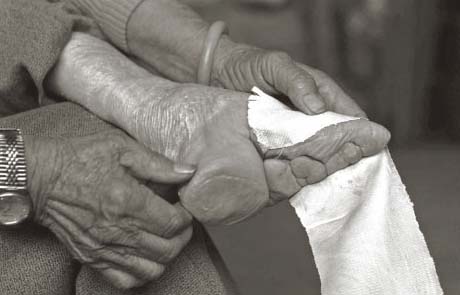
More recently, tattoos and skin piercing (currently popular in western societies) have become a must-have adornment for many people. These are just some examples of the kaleidoscopic range of body adornments that have been found to be attractive for different cultures. And there is the world-wide industry of male and female make-up, clothing design and cosmetic surgery that focuses so obviously on enhancing physical features. Our desire to establish intimate relationships will lead us to seek out certain people and present ourselves in the way that we feel will be most attractive to others. This in turn is shaped by the particular culture that we live in.
The emphasis our society places on physical attractiveness would suggest that each of us would seek long-term romantic relationships with the most attractive people we meet. But some of the research into relationship formation suggests that we are in fact more realistic and that we tend to form relationships with partners who are more of a physical ‘match’ to ourselves. This is called the matching hypothesis and has been supported by a number of studies. In one Bernard Murstein (1972) showed pictures of ninety-nine couples to participants. The pictures were separate so the participants could not know who paired with whom. Participants were asked to rate each picture for physical attractiveness. The scores for physical attractiveness of the real couples were much more similar than scores for randomly assigned couples.
This matching hypothesis does not contradict the previous view that we are attracted to people who are physically very attractive, but just highlights how, when it comes to actually making a choice, we temper ideals with a sense of realism. This process is sometimes explained in terms of costs and rewards. The costs of searching for a dream partner would be so high, if you consider the time needed and the likelihood of rejection if they are much more attractive than you are. Similarly people are not usually attracted to someone who is much less attractive than they are, because while the costs would be low, so would the rewards. Other psychologists suggest that, rather than being afraid of rejection, we are actually happier with someone more like ourselves, which ties in with what you were reading earlier about being attracted to people who are similar to us in all sorts of ways.
Think back to the information about schemas in Section 3.4. A schema is defined as a mental framework in which you would file all your knowledge about certain objects, situations, groups of people, even yourself. The view being suggested here on relationship formation suggests that people carry a mental schema that includes a set of characteristics that they would favour in a partner and that they seek out people who more or less conform to this. Research on schemas shows that factors other than appearance or physical attractiveness are seen as being more important when seeking a long-term partner. David Buss (1994), for example, studied unmarried college students in the US and found that the three top characteristics looked for in an ideal partner were: kind and understanding; exciting personality; and intelligent.
4.6 Staying together or falling apart
An initial attraction between two people begins a journey into the growing intimacy of a relationship. Psychologists have tended to describe and explain these intimate relationships in different ways. Robert Sternberg (1999), for instance, distinguishes between three different components of love as being ‘passion’, ‘intimacy’ and ‘commitment’. Romantic love, a combination of passion and intimacy, tends not to last when commitment is low. Equally, partnerships may last through high levels of intimacy and commitment while having low levels of passion.
But how are these intimate relationships nurtured and maintained? Why do some couples stay together for decades and others split within weeks? Is it possible to identify factors that could help us to evaluate the likelihood of a relationship lasting beyond the initial attraction?
Any relationship involves a complexity of layers of interaction. Each relationship has two perspectives, two sets of needs and expectations that have to be at least sufficiently met for the relationship to continue. These perspectives are not fixed, they change as people's needs and ambitions develop. This building of a relationship is carried out in different social settings in which there is usually a range of socially recognised norms and values influencing how people should behave towards each other – and in some cultures norms and values operate through quite strict guidelines, especially in relation to how opposite sexes should interact.
Activity 9: Your relationships
Think about your own relationship with a long-term partner or another couple you know who have stayed together (perhaps your parents or grandparents). Using Sternberg's idea of love involving passion, intimacy and/or commitment, to what extent are the different components important for your chosen relationship? Can you identify any specific strategies that you think might have contributed to keeping the relationship going?
Discussion
Every couple is unique (like the individuals involved) so you can’t generalise your experience to others and assume that what works in one relationship will work in another.
You may have noted strategies such as sharing interests including hobbies or going out together, humorous interactions, positive comments about each other and similar mutually bonding activities.
Observing interactions between couples can be a fascinating and rewarding approach taken by psychologists as they attempt to understand the internal dynamics of any relationship. For example, Kathryn Dindia and Leslie Baxter (1987) interviewed fifty married couples to try to identify strategies used to try to maintain relationships. They found that they could distinguish two types of behaviours, maintenance and repair. They identified forty-nine different strategies:
Maintenance strategies included:
talking about the day
giving compliments
regular contact (telephone calls) when apart during the day
socialising together with others
giving presents
joint discussion of purchases such as cars and holidays.
Repair strategies included:
talking about problems
seeking outside help
conceding to the wishes of the partner
issuing ultimatums.
You can see that there is clearly the potential for some strategies to be included in both categories for example, ‘gift giving’ and ‘keeping in touch’ when apart can be maintenance or repair strategies depending on the motivations involved and the needs of the situation.
Dindia and Baxter found differences in the type of behaviours adopted that related to the length of marriages. Those that had been married longer tended not to use maintenance behaviours as much as those who had only been married for a short time. It was suggested that the long-married couples knew each other better and were more familiar with each other, so did not feel the need for specific maintenance behaviours as much as those in the early stages of marriage. Another suggestion was that couples who had been together for a long time took maintenance strategies for granted and in a sense failed to notice the significance of their behaviours. It could be that they had already invested so much in the relationship that each felt the other did not need to be actively maintained.
John Gottman (1999) analysed videotapes of many couple's interactions over a period of 14 years. Through this extensive observational study, he found that couples who divorced tended to have four main problems: one or both partners spent a lot of time being critical of the other; one or both became very defensive when their faults were criticised; one or both tended to show contempt for the other; and one or the other refused to respond to the other during disagreements. Couples in more happy and successful partnerships seem to find a positive way of dealing with the four problem areas of criticism, defensiveness, contempt and unresponsiveness. Gottman found that couples who were more successful tended to be more supportive and less critical of each other which led to being more tolerant about each others’ weaknesses (in other words, they weren't trying to change each other).
This section has looked at a range of research findings on the kinds of relationships we engage in as adults and how close intimate relationships evolve. The factors that help to maintain an intimate relationship can vary considerably between couples but research suggests that such things as shared interests, the length of time the couple has been together, children, economic circumstances, individual expectations, past relationship experience and family support and culture are all relevant. And as for ‘romance’ and ‘love’… well this elusive area of human psychology is perhaps the most difficult to evaluate! The bonding power of love can help to overcome all of the factors that might inhibit relationship maintenance, and the absence of love might not be compensated for by the presence of most or even all of the positive factors that help to maintain an intimate relationship.
5 Group pressure
5.1 Introduction
Do you remember hearing about ‘Heaven's Gate’, the Californian doomsday cult which combined elements of Christianity with belief in the existence of UFOs? (A number of popular TV programmes, including CSI and The Simpsons, have based storylines on this cult.) In March 1997, thirty-nine members of the group, led by Marshal Applewhite and Bonnie Nettles, committed suicide in the belief that their souls would be transferred to a spaceship hiding behind the Hale-Bopp comet. Most of the cult members had severed contact with their families and had sold their worldly belongings. They had committed themselves to a celibate life, with eight of the men submitting to voluntary castration (seemingly in preparation for a new gender-free level of existence).
Why did these group members engage in such extreme behaviours? Had they been brainwashed? Were they just weak and vulnerable, in effect easy targets for manipulation? While psychologists offer a variety of explanations, most would recognise a combination of emotional and social factors at work and most would say that these go beyond the individual, their personality and their roles. Cult bonds are often created through such factors as the emotional attachment to the group and fear of powerful leaders making people feel dependent on the group (Margaret Singer, 1995). People can be highly attracted by the security offered by membership of a group, where friends are apparently all around you and you feel cared for and safe.
It's worth looking more deeply at how social psychologists have explored the ways in which groups and group identity influence the way people think and act. In this section you explore different strands of research to do with ‘in-groups/out-groups’, and ‘group pressure and conformity’.
5.2 ‘In-groups’ and ‘out-groups’
The two activities you did in Section 4 show how we associate ourselves with several different social categories and groups. These group identifications can promote a sense of identity and belonging – identities which help us define ourselves and others to define us. They can also raise our self-esteem and sense of status. The sense of group identity is then enhanced when we make comparisons between people like ‘us’ (the in-group) and people who are different, ‘them’ (the out-group). You can see this ‘us’ and ‘them’ thinking in many of the conflicts around the world today.
You can also see this thinking in everyday life, for instance played out with rival gangs or sporting teams. Teenage fashion is another great example. Consider, for instance, ‘skateboard culture’ and the dress code of this image-conscious group described by Janine Hunter (2006):
Members of the group are dressed in a very relaxed and informal style. Baggy jeans, T-shirts, maybe a hooded top and a key chain hanging from the side of a leg. Some have a favourite band or rock legend printed on their T-shirt, whilst others have a logo… Some of the skaters [are] wearing cut off shorts or rolled up jeans to three-quarter length, showing off their socks and trainers.
(Hunter, 2006)
Here is how one skateboarder describes the groupings demonstrating that group identity influences not only clothes but also the behaviour and ‘style’ that group members adopt:
…there's the punk skaters and then there are the rap hip-hop skaters and then … there are the people that are just, I dunno, whatever. Erm, basically you belong to one of those groups, you know, and it's the punk skaters that tend to be the ones that just throw themselves down the steps and do hand rails and stuff … and hip hop skaters tend to be like all techy, flippy crap and stuff …
(Hunter, 2006)
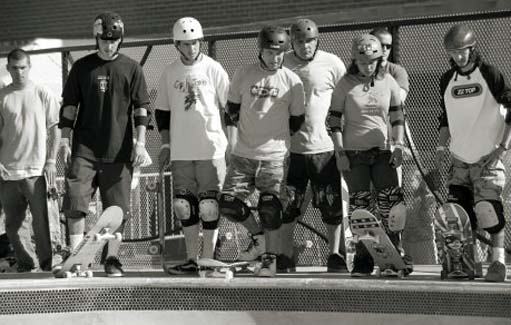
Activity 10: Us and them
Read the newspaper article below. Can you spot any indications of an ‘us and them’ kind of thinking? There is more than one ‘us and them’ indirectly being referred to in the article.
Ross asks BBC: ‘Where are all the black faces?’
Jonathan Ross sealed his reputation as a man willing to flirt with the unsayable yesterday when live on BBC radio he criticised the concentration of black people in low paid jobs. The target of his wrath? The BBC itself.
Ross, renown as a ‘motormouth’ chat show host, did not let his reported £6m annual pay stop him speaking his mind about his employer. Presenting his BBC Radio 2 show, he described a visit to the Chris Moyles show on Radio 1 where he met an employee with a small ‘Afro’ hairstyle. Ross demanded: ‘How many black people have they got working on proper shows there? You know the BBC still haven't really come up to speed. I mean they are trying, God bless them.’
‘Most of the guys you see there are either working on the door, carrying a cloth in there and cleaning up. We haven't really made the effort yet.’
The subject, which many employers would rather avoid, is especially sensitive at the BBC. Last year Mary FitzPatrick, its ‘diversity tsar’, told The Observer she believed foreign correspondents should be from the ethnic background of the country where they are based. She later denied this should be taken as a criticism of the likes of John Simpson and Fergal Keane for being ‘too white’.
In 2001 the then director general, Greg Dyke, labelled the BBC ‘hideously white’ and incapable of retaining staff from ethnic minorities. Last night Dyke took issue with Ross on at least one point: ‘It's certainly not true that there hasn't been an effort. While I was there I think we increased the total representation of ethnic minorities by two per cent.’
The BBC scrambled to answer Ross's broadside. A spokeswoman said: ‘The BBC is committed to ensuring that the organisation has a mixed and diverse workforce to guarantee a good understanding of the whole BBC audience, which includes people from a wide range of ethnic and social backgrounds.’
She said the BBC was aiming for 12.5 per cent ethnic minority employees in the workforce and seven per cent in senior management by December 2007. ‘As far as what Jonathan Ross said, he was expressing his personal opinions.’
(Smith, 2007)
Discussion
The clearest reference to ‘us and them’ is probably ‘blacks versus whites in the BBC’. Did you pick any others up such as ‘BBC workers versus front-line presenters’ or ‘BBC employees versus senior management’? Often, notions of ‘us and them’ are subtle and can be hard to spot unless you're a part of the in-group/out-group conflict.
Interest in the process of identification with groups received a strong impetus from a series of studies conducted in the 1950s and 1960s. Muzafer Sherif et al (1961), for instance, conducted an often cited series of experiments involving a boys’ summer camp.
Robber's Cave
The experimenters divided the boys into two groups. As expected the groups became quite cohesive involving norms of behaviour, jokes and secret codes. They set up a competition in the form of a tournament. Good sportsmanship quickly degenerated into overt group hostility with name-calling, aggression and prejudice in evidence. Within the groups, however, group loyalty, solidarity and cooperation were at its height. The experimenters then further manipulated the group situation by introducing activities which required both groups to actively cooperate and positively work together. This proved quite successful.
Experiments like these have demonstrated the significance of how conflict can arise through competition as groups interact over time. However, a series of other experiments known as the ‘minimal group experiments’ (Henri Tajfel et al 1971) shows something a little different. Tajfel and his colleagues showed that in-group favouritism and out-group discrimination can occur even when there is no history of involvement between groups. These researchers simply randomly assigned teenage boys to a kind of ‘virtual’ group. They were, in fact, working by themselves in a cubicle and just thought they were part of a group. Without any contact with others in their ‘group’ and with no real conflict of interest, they still showed in-group favouritism!
Would it surprise you to know that these results have been replicated many times in North America and Britain? However, there is also some contradictory evidence. When Margaret Wetherell (1982) applied these minimal groups in New Zealand, she found that while white European New Zealand children showed the same pattern of behaviour as North American/British children, Pacific Island and Maori children did not necessarily opt for in-group favouritism. Instead, they repeatedly chose to benefit both groups, even if this meant their group getting less than the out-group. Wetherell explains how this made sense in terms of their cultural framework. She notes, for example, that in Polynesian societies generosity is a mark of high status. Results such as these highlight the importance of wider cultural factors which affect our social identities and the extent of group influence.
Ideas about in-groups and out-groups form the basis of a psychological theory called Social Identity Theory, first developed by the psychologists Henri Tajfel and John Turner (1979). The theory argues that our response to joining groups involves three key stages:
Social categorisation: Here we put ourselves and others into categories: for example, we label someone a rapper, a snob, a trekkie, a Christian, an Essex girl, and so on. These labels then become a shorthand way of implying other things about that person. (Didn't certain images come to mind when you read those labels?)
Social identification: As soon as we are identified as belonging to one group rather than another, we take up that identity in our own and others' eyes. We become defined in a way that also has some emotional or value significance. What we and our group do is ‘good’, ‘cool’ and so forth.
Social comparison: As members of a group, we then compare our group with others. In the process, we will define our group in positive terms, thereby reinforcing our own positive view of ourselves. There is also a competitive element in our response to other groups. Out-groups are seen in negative terms, and perhaps even actively discriminated against. Thinking well of ourselves and bolstering group self-esteem therefore becomes linked with discrimination against, and hostility towards, other groups.
Social Identity Theory highlights both how people's sense of who they are is defined in terms of a ‘we’ instead of simply an ‘I’, and that in-group categorisation occurs in ways that favour the in-group at the expense of the out-group. People want to feel their own group (and therefore themselves) as being better than other groups.
Social Identity Theory is one of many different psychological theories put forward to explain some of the causes of racist attacks and group conflicts and wars around the world. While it would be too simplistic to say that all group conflicts are down to social identity (you already know that there are multiple influences on people), research evidence backs up the ideas of in-group favouritism and out-group discrimination playing a part. Prejudice based on this is a way of bolstering self-esteem in that it allows ‘out-groups’ to be seen as inferior.
The evidence suggests that the desire for self-esteem leads to inter-group competition and that these processes can escalate into open hostility and discrimination. In other words, simply categorising people into groups may be sufficient to generate conflict and prejudice between groups. The argument here is that individual differences between members of both in-groups and out-groups tend to be ignored. This results in stereotyping: the over-simplified, distorted, and one-dimensional portrayal of people, perhaps based on their sex, race, religion, profession or age. For instance, think about the stereotype of ‘dumb blondes’ which suggests that all blonde women are stupid when the reality is that intelligence is not related to hair colour. Then there are more serious examples of stereotypes, for example, when a Muslim is wrongly assumed to be a ‘terrorist’. This occurs in people's thinking as a way of simplifying and organising a complex world. The problem with such unfortunate stereotypes is that they can have problematic, even critical, consequences.
Psychologists who have studied this subject argue that as we seek to make sense of our complicated, confusing world, we inevitably stereotype people to some degree. In a sense, people have to simplify and make generalisations. The problem arises when negative caricatures result in prejudice and are used to justify discrimination against one group by another. Such portrayals can profoundly affect how we value ourselves and relate to one another in groups.
5.3 Groups and conformity
In the 1950s, Solomon Asch conducted what are now regarded as classic experiments on how individuals can be pressured to conform to a group's standard. The results of his experiments dramatically showed the influence of group pressure.
Activity 11: Conformity and group pressure
The following passage describes one of Asch's experiments. As you read, try to imagine that you are a participant yourself in the experiment and guess how you might have responded.
You are seated round a table with six other people taking part in an experiment on the ways we perceive things. Your group is shown a picture of a straight line. You're all then given a picture of three more lines of different lengths. You are asked to pick out the line equal in length to the original one, as below.

Is this line length similar to line 1, 2 or 3?
Each person at the round table identifies their own choice out loud – you're the last but one to speak. The first five people opt for line 2. Do you agree with them?
Can you think of one occasion in real life where you have been subjected to some form of group pressure? Perhaps you were in a pub and your friends pressed you to have another drink and stay a bit longer, when really you wanted to leave. What happened and what did you do? What, if anything, would have swayed you to go along with the group? Write some brief notes describing your experience.
Discussion
In Asch's experiment this exercise was done many times with different line lengths. What you won't have realised is that the people in the experimental group, bar one participant, were actually in league with the experimenter and occasionally gave the same false answers deliberately! What was being tested was whether or not the one genuine participant felt the group pressure to conform to the others' opinions. So, did you?
Of course it is impossible to say with this paper exercise whether or not you really would have actually succumbed to the influence of the group pressure. What might have happened would be for you to conform publicly but disagree privately. (This is something that happened quite a lot in Asch's experiment too.)
Some situations and groups somehow exert more pressure than others; and at some times more than at others. If you've experienced the pub situation, for example, you've probably found it easier to resist the pressure on some occasions and harder on others. The key then is to think about what ingredients make you want to conform, for instance, perhaps you are wanting/needing to be accepted, and approved of, by that group.
Out of fifty participants in Asch's original study, 75 per cent conformed to an obviously wrong answer given by the rest of the group at least once. However none of the participants conformed on every occasion the group gave wrong answers.
Asch went on to investigate how variations in the experimental situation would affect the frequency of conformity and resistance to conformity. He increased the difficulty of the task so that the lines were of similar lengths and found that conformity levels increased. Introducing an element of disagreement among the fixed group members encouraged the true participant not to conform. Also allowing the participant to write down their answer rather than say it out loud resulted in much lower levels of conformity. This supports the suggestion that in the original experiments many participants were publicly agreeing with the majority but privately disagreeing.
However Asch's results from the original experiment were still surprising as the correct answer was always very obvious. Some psychologists have suggested that the results Asch obtained were linked to the historical and cultural setting of the USA in the early 1950's as later studies or studies carried out in different countries have not always replicated Asch's findings. In the 1950s America was very conservative. Also the participants that Asch used in his study were college students and colleges then were much more hierarchical than they became later. This cultural background could have encouraged a high level of conformity.
Rod Bond and Peter Smith (1996) reviewed a number of studies carried out in different cultures using the Asch line judgement task. They found that levels of conformity were much higher in collectivist cultures, such as China, than in individualistic cultures, such as the USA. Collectivist cultures tend to emphasise the needs of the group over the needs of the individual whereas in individualistic cultures the needs of the individual take precedence. As collectivist cultures also stress the importance of adhering to group norms and supporting group decisions then it is not surprising that conformity levels will be higher.
Conformity is sometimes presented in a negative way especially when we see participants being manipulated in an experiment to give obviously incorrect answers as a result of group pressure. However it is worth considering that a certain level of conformity is necessary for any society to operate for the benefit of the vast majority of the members. It would be difficult for an audience in a theatre to enjoy a play if one person kept interrupting the actors and commented loudly on the story. Also it would feel very uncomfortable if the person in front of you on an escalator decided to turn round and stare at you as you travel to the next floor.
In this section you've explored some of the work carried out by social psychologists on group identities. You've seen how people can take up certain group identities which can give them a sense of belonging and self-esteem or result in negatively stereotyping, and possibly discriminating against, out-groups. While pressures to conform to groups can make individuals behave in ways that go against the grain, individuals can resist such pressures. The group can both influence the individual and act as a source of individual empowerment. The influence of groups tends to work most powerfully when supported by the wider culture.
6 What makes us who we are?
6.1 Introduction
When answering the question ‘What makes us who we are?’, psychologists – as you now know – put forward a range of explanations about why people feel, think and behave the way they do. Just when psychologists seem to understand one bit of ‘who we are’, up pops some new evidence to show a different side! It is not easy to pin down all the many influences.
Each of the previous sections of this course has focused on one approach to explaining ‘What makes us who we are?’. In this section you will have the opportunity to combine a number of different possible explanations to try and get a more complete picture of why a person thinks or acts in a certain way. You have seen, from your reading of previous sections, how people can be influenced by different aspects such as their brain and biology, thinking, relationships and social identities and how different types of psychologists (biological, cognitive, developmental and social) tend to favour certain explanations. Now it's time to put those pieces together and recognise that there are invariably multiple influences at work. This is the key lesson of this section.
This section will examine the multiple and interlinking influences at work on people's minds and behaviour coming from both inside and outside the individual.
6.2 Multiple influences
Human beings are complex and it's rarely easy to work out exactly why someone thinks or behaves in a certain way. An interplay of factors are invariably involved both within the individual themselves and outside to do with their wider social context. Factors within the individual include their biology, their thoughts and their feelings. Influencing factors coming from outside include things like relationships, social identities and the wider culture.
However, what is happening ‘inside’ and ‘outside’ a person is invariably interconnected. For example, when we think about something, it's usually related to something outside ourselves. Other psychologists argue that the inside is really a reflection of what's going on outside so it can't be separated out. ‘There is no inner man’, a philosopher called Maurice Merleau-Ponty explains, ‘man is in the world, and only in the world does he know himself’ (1962, p. xi). That said, the words ‘inside’ and ‘outside’ offer a useful short-hand description (and one that fits this course nicely): ‘inside’ factors are the ones discussed in Sections 2 and 3 while the ‘outside’ factors are explored in Sections 4 and 5. Looked at another way, you can see the ‘inside’ referring to personal factors to do with the individual themselves, while the ‘outside’ relates to social influences where other people are involved.
What follows is a case study which will give you an opportunity to think about a number of different influences on a person's behaviour.
6.3 The Zidane head-butt
The case study to be considered is an incident from the 2006 World Cup Final between France and Italy. The two players involved are Zinedine Zidane, playing for France who head-butted the chest of Marco Materazzi, who was playing for Italy.

Activity 12: The incident
Read the following description of the incident, and note down any thoughts you have about what happened.
The incident happens in the second period of extra time (around 110 minutes into the match). Materazzi moves to stand behind Zidane and then holds onto him with an arm round his chest. Both players are looking in the direction of the ball. Materazzi lets go of Zidane and Zidane looks towards him. Materazzi says something and pats Zidane on the back. Both players start to move down the field in the direction of play while talking to each other and then Zidane begins to jog so that he is in front of Materazzi. Materazzi is still speaking in the direction of Zidane. Zidane turns to face Materazzi and then steps towards him whilst lowering his head. He then head-butts Materazzi in the chest. Materazzi drops to the ground.
Discussion
What notes did you make about what you read above? Did they include some interpretations of the behaviour? Did you wonder why the players were behaving as they did? Imagine you were actually watching this incident happen rather than reading about it.
It is very tempting when observing behaviour to go beyond what you see and start to make inferences. For example if you watched someone being told a joke by another person and then laughing it would seem reasonable to describe the situation by saying that the person found the joke funny and laughed. The laughing is an observable action but the suggestion that they did so because they found the joke funny is an inference. We don't know they found the joke funny we just think we know. There could be a number of other reasons for the laughter. Some people laugh when they feel nervous or the joke may have caused feelings of anger which the person was attempting to disguise or they may even be laughing at something else they can see or something else they are remembering.
There is nothing wrong about making inferences and trying to interpret or explain behaviour – much of this course has been concerned with attempts to interpret behaviour by looking at different possible explanations. However it is important to distinguish between what you observe and how you might interpret this behaviour because several different interpretations may be possible.
In the Zidane incident, now that we have a description of what happened, the next step is to attempt some explanations for this behaviour. However, first it might help if you have some more background information about Zidane.
6.4 Zidane's background
Zidane was born in 1972 in the French city of Marseille to parents who came originally from Algeria. He is the youngest of five children and the family lived in a working class district of the city called La Castellane. Zidane began his football career early and was playing in the junior league at the age of 14 and in First Division football at the age of 17. He developed into a world class player and was three times named World Player of the Year. The 2006 World Cup Final was to be his last game of professional football before he retired.
The head-butting incident occurred in the 110th minute of the game, when the game had gone into extra time, and it resulted in Zidane being sent off. He was not able to take part in the penalty shootout which Italy won 5–3. This was a very sad end to an outstanding football career for Zidane, his fans and for France.
What followed was hours of debate and discussion in the media and at social gatherings when people tried to answer the question of why? What made this footballer react so aggressively and some would say stupidly in such an important match and at such an important time in the match? Zidane stated he had been provoked by Materazzi who had made insulting remarks about his mother and sister. Materazzi insisted that he had made some trivial remarks and had said nothing about Zidane's mother.
Even if you're not very interested in football, perhaps you have some views about why footballers might behave in this way. In the next activity, you are given the opportunity to hear different people's views. You will explore the different explanations people put forward about what made Zidane behave that way.
Activity 13: Why did he do it?
Before watching the video below make some notes listing all the different explanations for why Zidane head-butted Materazzi you can think of. It might help if you think about the different influences you have read about in this book. Can you suggest any factors related to Zidane's biological state, his thinking, relationships and social identities that could help to explain what happen?
Once you have completed your notes watch ‘Everyday explanations’, which shows some members of the general public offering their views on what happened. Compare your explanations with theirs.
Discussion
Did you find that your explanations covered more sources of influence than those of the general public? It is worth thinking about the way you would normally regard the behaviour of a footballer who ‘hits out’. Have you been inclined to explaining such behaviour in simple or straightforward terms, such as saying, ‘it all comes down to…’? Has doing this reading helped you see some other possibilities?
Next you'll examine the explanations proposed by three psychologists who are focusing on three different types of influence.
Activity 14: Explanations from three psychologists
Now listen to ‘Psychological explanations’. This shows three psychologists, one biological, one cognitive and one social giving their interpretation of what happened. Make notes of the key points of each explanation
Please note: the audio clips below are taken from the Y183 course DVD and so you will notice references to chapters in the course which are not represented here.



Discussion
The biological psychologist suggested that there may be a genetic predisposition for men to react to provocation with physical aggression more than a women would. The role of testosterone is not clear, although there is a link between this male sex hormone and aggression. However the stress engendered by the situation that Zidane was in would have caused a release of adrenalin and biological arousal which in turn would intensify any type of emotional response.
The cognitive psychologist highlighted the role of schemas and top-down processing in influencing the interpretation of the situation and the response to the situation. He also highlighted selective attention in that provocation might be unnoticed or ignored when attention is focused elsewhere. Interestingly the football schema may also have determined the type of response so that Zidane head-butted Materazzi rather than punched or hit him.
The social psychologist emphasised the role of social identities. He described a number of identities for Zidane – a man, a football player, a team member, a French person, a symbol of multiculturalism and a person with a working class background. It is interesting that Zidane himself tried to explain his behaviour by referring to the idea of having to be a ‘man’ (his gender identity) and his need to stand up to anyone who insulted his mother and sister. In addition in his North African culture a female relative is seen as being sacrosanct and dealing with insults would be a matter of ‘family honour’(cultural identity).
To attempt a complete explanation you could suggest a rush of chemicals in the body was precipitated by the stress of the wider social situation (including public and media pressures) which the footballer didn't deal with particularly well given his relationships with people involved, upbringing and culture. Most psychologists today would accept that any useful explanation, such as the one given for the Zidane head-butt, is going to describe an interaction of both internal and external influences.
Conclusion
This free course provided an introduction to studying Environment & Development. It took you through a series of exercises designed to develop your approach to study and learning at a distance, and helped to improve your confidence as an independent learner.
A level Psychology with the NEC

What really makes people tick? What factors affect mood and behaviour? If the complexities of human behaviour interest you, further study will open up some fascinating answers. By studying psychology at A level, you’ll hone the scientific skills required to investigate and analyse different conditions, situations and theories.
Explore thought-provoking topics including memory, early cognitive development in children, schizophrenia and depression, in the online A level Psychology course from the National Extension College (NEC).
Enrol from £750.
References
Acknowledgements
Grateful acknowledgement is made to the following sources for permission to reproduce material in this course:
Course image: Loco Steve in Flickr made available under Creative Commons Attribution-NonCommercial-ShareAlike 2.0 Licence.
Except for third party materials and otherwise stated (see terms and conditions), this content is made available under a Creative Commons Attribution-NonCommercial-ShareAlike 4.0 Licence
Extract from Smith. D. ‘Ross asks BBC: “Where are all the black faces?”’ on http://observer.guardian.co.uk. Guardian.; extract from Kondo, D.K. (1990) Crafting Selves: Power, Gebder and Discources of Identity in a Japanese Workplace, The University of Chicago Press.
Figure 1 Jack Jones/© f1 online/Alamy;
Figure 8 © Profimedia International S.R.O/Alamy;
Figure 10 © Rex Features;
Figure 11 © David Young-Wolff/Alamy;
Figure 13 Copyright © Popperfoto/Alamy.
© Science Photo Library
Don't miss out:
If reading this text has inspired you to learn more, you may be interested in joining the millions of people who discover our free learning resources and qualifications by visiting The Open University - www.open.edu/ openlearn/ free-courses
Copyright © 2016 The Open University
